Urban hedgerows over 20 meters long are protected by the Hedgerow Regulations 1997. You’ll need permits for removal or significant alterations, especially during bird nesting season (March-August). Height restrictions typically cap at 2 meters for residential areas, with visibility requirements near intersections. Maintain your hedgerow between September and February, and guarantee it doesn’t encroach on neighboring properties. Proper understanding of these regulations will help you avoid potential fines and disputes.
Hedgerow Maintenance Laws: Urban Requirements Guide
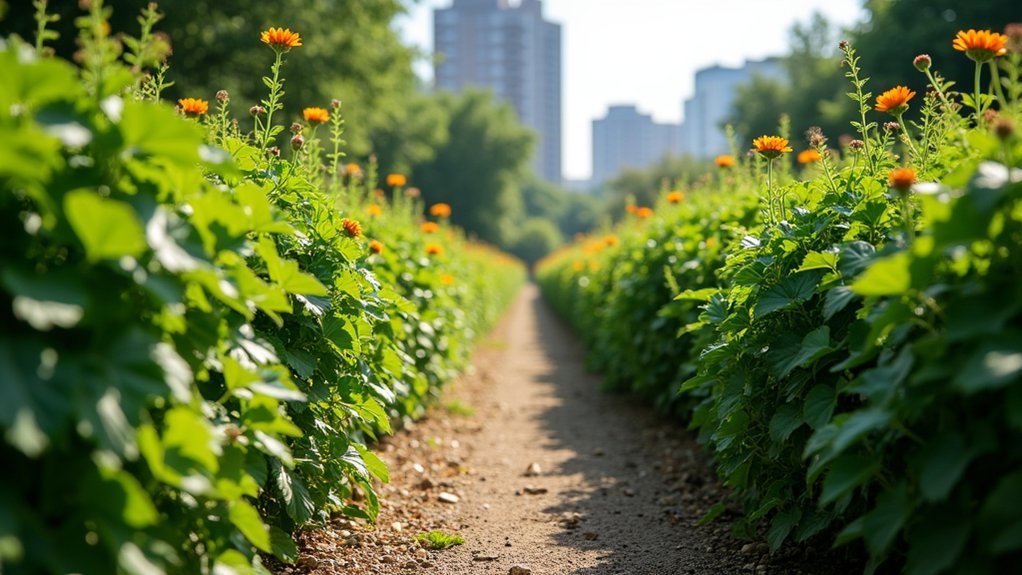
While many property owners might view hedgerows as simple boundary markers, these living structures are actually protected under the Hedgerow Regulations 1997 in urban environments.
If you’re planning to remove or alter hedgerows on your property, you’ll need to comply with local planning policies and obtain necessary permissions.
Effective hedgerow management requires you to work outside the bird breeding season (March 1 to August 31) to protect nesting habitats.
Protect nesting birds by scheduling hedgerow maintenance between September 1 and February 28.
When developing land with existing hedgerows, you must consider mitigation options like on-site retention, translocation, or replanting with similar species.
For ideal urban hedgerows, prioritize native species in your planting schemes.
This approach promotes biodiversity while maintaining the dense structure that enhances ecological value in urban settings.
Legal Definitions of Urban Hedgerows
You’ll need to understand urban hedgerow classifications to guarantee compliance with local regulations.
Urban hedgerows are legally defined as linear plantings exceeding 20 meters in length and less than 5 meters in width, containing multiple native species that serve as urban boundaries.
Legal height restrictions vary by municipality, but generally limit residential hedgerows to 2 meters adjacent to highways and require permits for hedgerows exceeding established height thresholds.
Urban Hedgerow Classifications
Although many homeowners might consider any garden boundary a hedgerow, legal definitions apply specific criteria to urban hedgerows. Under the Hedgerows Regulations, urban hedgerows must be over 20 meters long, less than 5 meters wide, and have gaps smaller than 20 meters.
The classification depends heavily on the presence of native species, which determines their ecological significance in urban environments.
- Your garden hedge isn’t just a boundary—it’s a lifeline for struggling urban wildlife maneuvering through concrete jungles.
- When you maintain your native species-rich hedgerow, you’re preserving critical wildlife habitats that countless creatures depend on.
- Every protected hedgerow you help preserve creates another essential link in the fragmented ecosystem of our cities.
Legal Height Restrictions
Beyond their ecological classification, urban hedgerows must also comply with specific height regulations that protect public safety and neighborhood aesthetics.
You’ll find legal height restrictions vary according to local council regulations, typically limiting hedgerows to around 2 meters in urban settings.
The Hedgerow Regulations 1997 establish criteria that define acceptable dimensions for urban hedgerows, ensuring they don’t interfere with overhead utilities or obstruct visibility for drivers and pedestrians.
Before planting or modifying your hedgerow, check your council’s specific guidelines to avoid potential enforcement issues.
Remember that non-compliance with these restrictions can result in fines or mandatory removal orders.
When planning your urban hedgerow, always factor in these height limitations to maintain both legal compliance and good neighborhood relations.
Height and Width Restrictions for Residential Areas
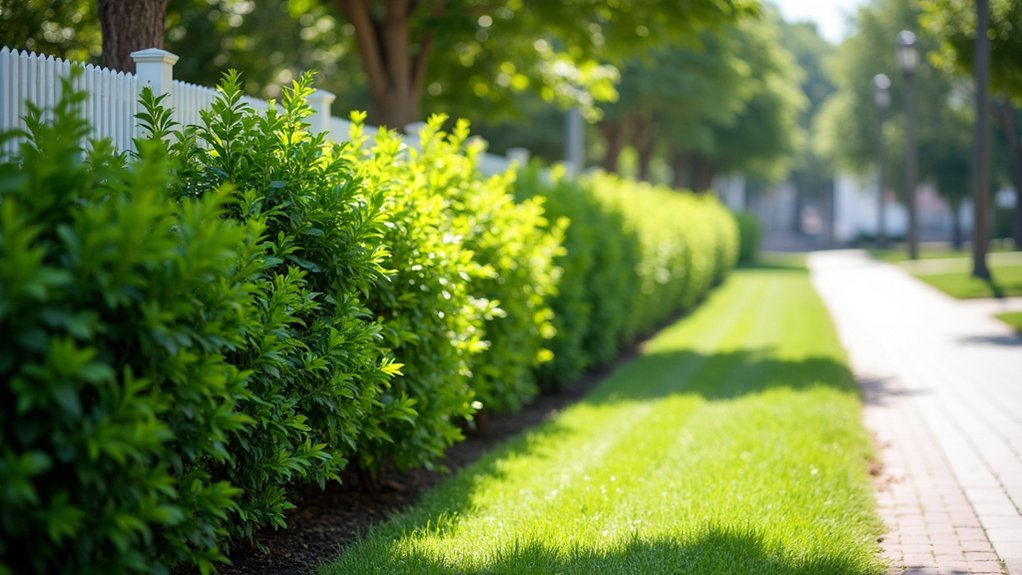
If you’re maintaining hedgerows around your residential property, you’ll need to follow local height restrictions, typically capped at 2-3 meters to prevent light obstruction for neighboring homes.
Width limitations generally require keeping hedges between 1.5 and 2 meters across to maintain community aesthetics and accessibility.
You should check with your local planning authority before planting or trimming, as non-compliance with these boundary regulations could result in disputes or mandatory alterations.
Boundary Height Limits
While many homeowners take pride in their lush, natural boundaries, residential hedgerows must conform to specific height and width restrictions. Your boundary line of trees typically can’t exceed 2 meters in height according to local planning regulations.
You’re also responsible for ensuring your hedgerow doesn’t spread beyond 2 meters in width to maintain aesthetic balance in urban settings.
You must maintain hedgerows to prevent encroachment onto public paths and roads, as this creates safety hazards for pedestrians and drivers. Failure to comply may result in enforcement actions.
- Oversized hedges can block essential sunlight from your neighbor’s property, creating tension within your community.
- Well-maintained boundaries show respect for shared spaces and community standards.
- Properly trimmed hedgerows enhance your property’s appearance while respecting others’ rights to light and views.
Width Control Guidelines
Maintaining proper width control for your residential hedgerows is just as important as managing their height. While height restrictions typically cap at 2 meters (6.5 feet), width control guidelines generally require keeping hedgerows within 1 meter (3.3 feet) from your property boundary. This prevents encroachment onto public pathways and guarantees pedestrian safety.
Your local planning authority may enforce specific regulations governing hedgerow dimensions, particularly in urban settings where space is limited. Regular maintenance is essential to comply with these requirements and avoid potential enforcement actions.
Trimming your hedgerows to the prescribed width not only keeps you in compliance with local regulations but also prevents disputes with neighbors over light access and boundary encroachment.
Before establishing new hedgerows, consult your council for area-specific width control guidelines to guarantee compliance.
Seasonal Trimming Windows and Wildlife Protection
Careful timing of hedgerow maintenance serves as the cornerstone of wildlife protection efforts.
You’ll need to schedule your trimming between January and February to avoid disrupting nesting birds protected by law. Following a 2-3 year trimming cycle promotes healthier hedges while ensuring wildlife has access to winter berries and habitat.
- Imagine the disappointment of discovering you’ve accidentally destroyed a bird’s nest because you trimmed during breeding season.
- Consider the satisfaction of watching your rejuvenated hedge become a thriving ecosystem for local wildlife.
- Feel the pride of knowing your proper hedge management directly contributes to biodiversity in your community.
When filling gaps, choose native species to enhance habitat connectivity.
Property Boundary Rights and Responsibilities
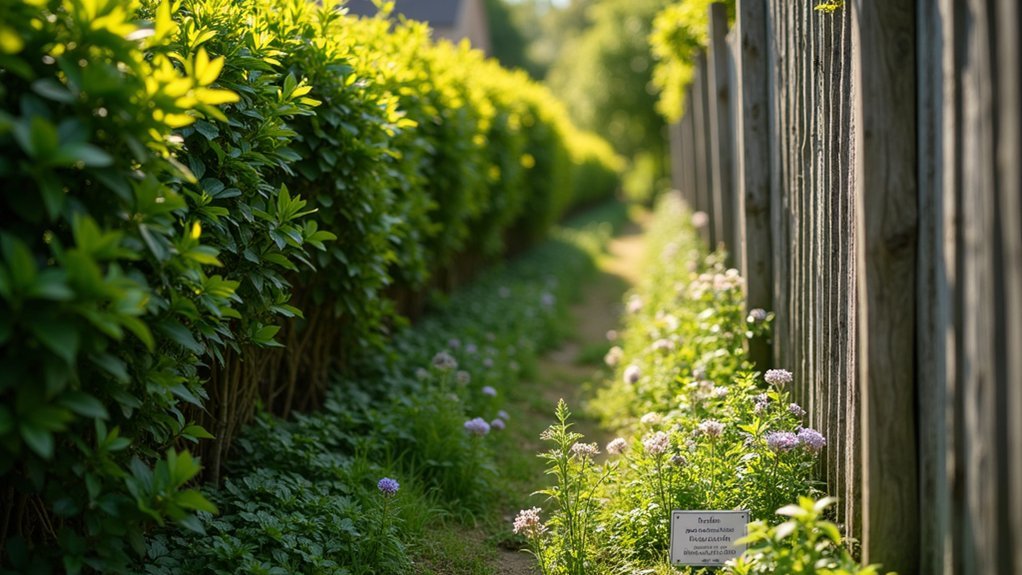
Hedgerows do more than shelter wildlife—they define where your property ends and another begins. As a property owner, you’re responsible for maintaining hedgerows along your boundary to prevent encroachment onto neighboring land or public pathways.
Under the Hedgerows Regulations 1997, you’ll need consent to remove or considerably alter hedges over 20 meters long and under 5 meters wide. Your neighbors have rights to trim branches that overhang their property, but they can’t damage your hedge’s core structure or root system.
Important: Hedgerow removal requires legal consent, while neighbors may trim overhanging branches without harming the hedge itself.
Before making changes to boundary hedgerows, consult your local planning authority as they may impose specific maintenance conditions.
If disputes arise over shared boundary hedges, the Party Wall Act provides a framework for resolution, clarifying the rights and responsibilities of both parties.
Native Species Requirements and Invasive Plant Prohibitions
You’ll need to incorporate native species in your urban hedgerow plantings to support local wildlife and comply with regulations like the Hedgerow Regulations 1997.
Invasive plants such as Japanese knotweed and Himalayan balsam are strictly prohibited due to their destructive impact on biodiversity and tendency to overwhelm native vegetation.
Local planning authorities may enforce specific guidelines requiring native species selection during hedgerow establishment or restoration to enhance environmental value and meet biodiversity objectives.
Native Plant Benefits
While modern landscaping often focuses on ornamental appeal, native plants form the ecological backbone of Britain’s hedgerows, supporting over 600 plant species and providing essential habitat for 65 bird species and 20 mammal species.
The Hedgerows Regulations 1997 emphasize using native species to enhance ecological integrity and create wildlife corridors.
When you incorporate native shrubs and trees into your hedgerow management plan, you’ll:
- Create year-round food sources of berries and nuts that local wildlife depends on for survival
- Build natural resistance against pests and diseases, reducing chemical interventions
- Preserve the local ecosystem’s identity and protect it from invasive species that outcompete native flora
Invasive Control Laws
Legal frameworks safeguard the native composition of Britain’s hedgerows through extensive invasive control regulations.
You’re legally bound by the Wildlife and Countryside Act 1981, which protects native plants by making it illegal to uproot or damage them in established hedgerows.
The Environmental Protection Act 1990 specifically targets problematic invasive species like Japanese knotweed and Himalayan balsam.
You must implement control measures to protect native ecosystems and prevent their spread. Local bylaws often mandate the complete removal of these non-native invaders from hedgerows.
You’re also obligated to regularly monitor and report invasive species in your hedgerows.
This vigilance helps authorities track potential threats and guarantees your compliance with legal requirements, ultimately supporting conservation efforts that maintain the biodiversity value of Britain’s hedgerow networks.
Visibility and Safety Regulations at Intersections
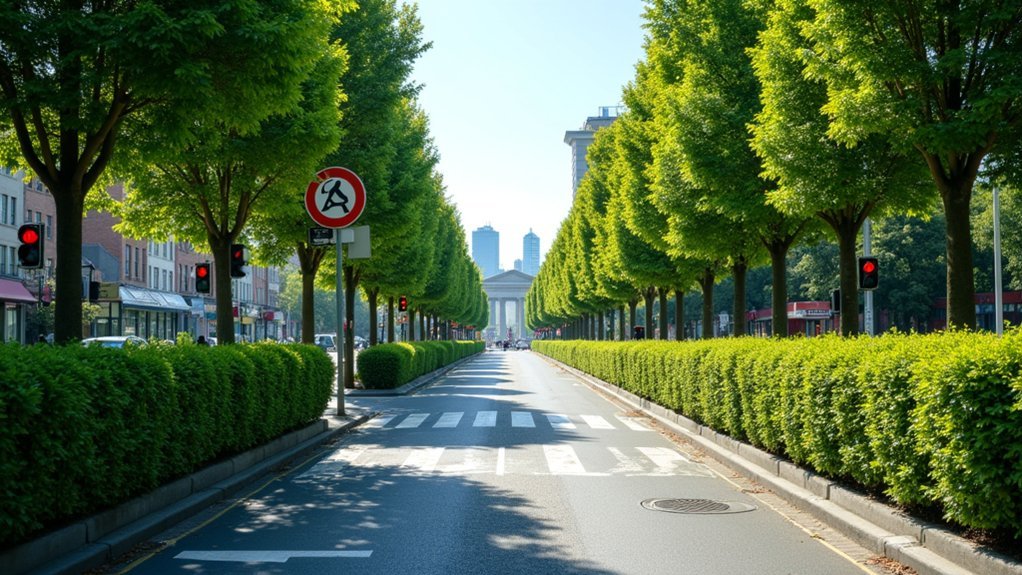
Three critical factors determine hedgerow compliance at intersections: height, distance from the corner, and maintenance frequency. Your hedgerows must remain below 0.9 meters (3 feet) within 2-5 meters of intersection corners to maintain proper visibility for drivers and pedestrians.
Local authorities typically require trimming once or twice yearly to guarantee ongoing compliance with these safety regulations.
- Ignoring these regulations puts lives at risk—imagine a child on a bicycle hidden by your overgrown hedge.
- You’ll face potential fines and mandatory removal orders if your hedgerows obstruct critical sightlines.
- Consulting with local planning officials before planting can save you future heartache and expense.
Remember to check your specific local requirements, as visibility standards may vary between municipalities.
Permit Requirements for Major Hedgerow Alterations
Beyond maintaining proper visibility at intersections, you’ll need to evaluate permit requirements when planning significant changes to your hedgerows.
Under the Hedgerows Regulations 1997, any hedgerow exceeding 20 meters that contains native species typically requires a permit before removal or significant alteration.
Native hedgerows over 20 meters require regulatory permits prior to any significant modifications or removal under the 1997 Regulations.
Your application must include evidence of the hedgerow’s historical significance and its contribution to local biodiversity.
Planning authorities will assess the ecological value of your hedgerow, often consulting with environmental agencies before making decisions.
If your hedgerow is classified as important, you’ll only receive approval for alterations if you can demonstrate compelling reasons like public safety or development necessity.
You’ll also need to submit a compensatory planting plan.
Proceeding without proper permits may result in fines and mandatory restoration requirements.
Neighbor Dispute Resolution Procedures
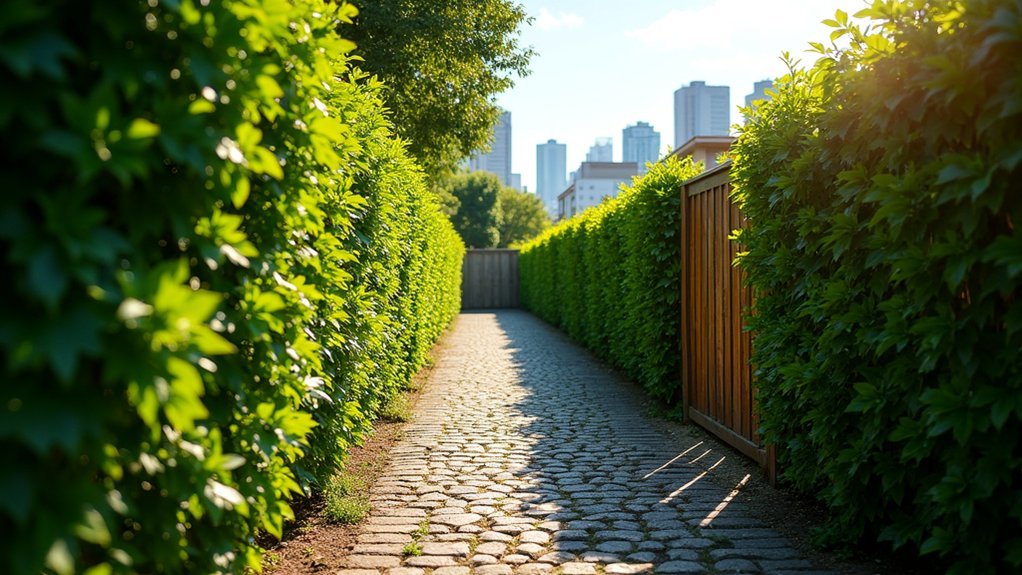
Common disputes with neighbors over hedgerows often require structured approaches to find resolution. When facing conflicts over maintenance responsibilities or boundary issues, first consult your local regulations to understand the legal framework surrounding hedgerow management in your area.
Documentation is essential—keep photographs of the hedgerow and maintain records of all communications with your neighbor.
- Approach your neighbor calmly to discuss concerns before tensions escalate into deep-rooted resentment.
- Consider professional mediation services which can transform hostile confrontations into productive conversations.
- Reach out to your local council for guidance that might prevent costly legal battles and preserve neighborhood harmony.
If mediation fails, your documented evidence will prove invaluable should the dispute require formal legal intervention.
Exemptions for Heritage and Protected Hedgerows
While many hedgerows fall under standard maintenance regulations, heritage and protected hedgerows enjoy special legal status that exempts them from routine cutting and removal practices.
Under the Hedgerows Regulations 1997, hedgerows over 30 years old with historical significance receive legal safeguards against removal or damaging alterations.
For your hedgerow to qualify for protection, it must be designated as “important” based on criteria including species diversity, historic significance, and landscape contribution.
You’ll need permission from your local planning authority before making significant changes to protected hedgerows.
However, exemptions exist for hedgerows in poor condition or those previously managed in ways that compromised their biodiversity.
If you’re a developer, you’re encouraged to incorporate protected hedgerows into your designs or provide compensatory habitat creation elsewhere.
Enforcement Mechanisms and Compliance Penalties
Although hedgerow regulations offer essential ecological protection, they’re only effective when properly enforced. Your local planning authority serves as the primary enforcer of hedgerow protection laws, regularly evaluating compliance during development projects.
Hedgerow regulations protect vital ecosystems but rely entirely on consistent enforcement by local authorities.
If you fail to follow regulations, you’ll face compliance penalties including fines or mandatory restoration orders requiring you to replant damaged hedgerows.
- The Environment Agency and Natural England actively monitor your hedgerow management practices, ensuring you maintain sustainable management standards.
- Your neighbors and community members can report your illegal hedgerow removal, creating a neighborhood accountability system.
- Ignoring regulations could result in legal action against you, potentially damaging your reputation and financial standing.
Frequently Asked Questions
What Is the Hedgerow Management Cycle?
You’ll need to manage your hedgerow through regular trimming every 2-3 years and complete rejuvenation (laying or coppicing) every 40+ years. Don’t forget annual trimming for young hedges during their first five years.
How to Maintain a Laid Hedge?
You’ll need to trim your laid hedge in late winter, cut incrementally higher each year, and rejuvenate it through laying or coppicing every 40+ years. Don’t forget annual trimming for the first five years.
What Is a Boundary in a Hedgerow?
A boundary in a hedgerow is a continuous linear feature you’ll find extending at least 20 meters with width under 5 meters. It’s marked by gaps not exceeding 20 meters and separates different land uses.
How Many Miles of Hedgerow Are There in the UK?
You’ll find the UK boasts around 500,000 miles of hedgerows, making it one of Europe’s most extensive networks. They cover approximately 10% of the UK’s land area and support incredible biodiversity.
In Summary
You’re now equipped to manage your urban hedgerows legally and responsibly. Remember, you’ll need to maintain proper heights, respect trimming seasons for wildlife protection, and understand your boundary responsibilities. Don’t forget that permits are required for major alterations, and heritage hedgerows have special protections. If you’re facing disputes, follow proper resolution channels to avoid penalties and maintain neighborhood harmony.





Leave a Reply